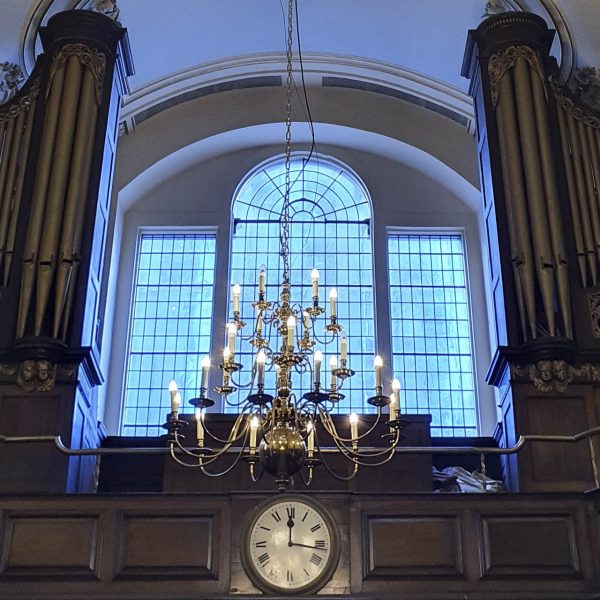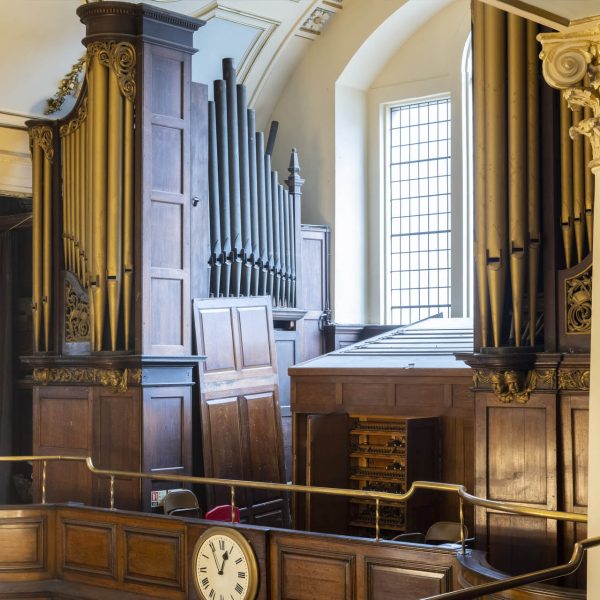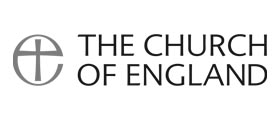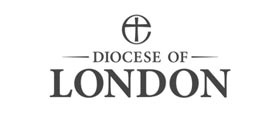Since the devastating damage to the church caused by the IRA Bishopsgate bomb of 1993, the pipe organ in the west end of the gallery has not worked. Instead, our Director of Music has had to manage valiantly with an electronic imitation organ which is now failing.
Building a new organ in the gallery, of similar but enhanced design to the existing defunct instrument, will restore the church interior to its former glory and, according to the Rector, Fr David, be a fitting celebration of the church’s 300th anniversary. The mediaeval church building, having been patched up by successive repairs and partial reconstructions for centuries, and having narrowly escaped the Great Fire of 1666, was finally deemed irreparable in the early years of the eighteenth century. The parishioners sought, and obtained in 1723, an Act of Parliament to demolish it and replace it with a new church building. The first stone of our current church was laid in 1725. The new building was consecrated in 1728, though not completed until the next year, 1729. The original organ was built some three decades later.
St Botolph’s Aspiration
Just before the start of the Covid pandemic, St Botolph’s PCC, with the assistance of its organ consultant, Professor David Titterington, Head of Organ at the Royal Academy of Music, and the Director of Music, Iestyn Evans, invited three organ builders to tender to build a new organ in the church. After extensive research and preparation of proposals by the companies, significantly delayed due to Covid, the PCC unanimously agreed in October 2021 that the contract should be awarded to US firm C B Fisk inc. of Gloucester, Massachusetts.
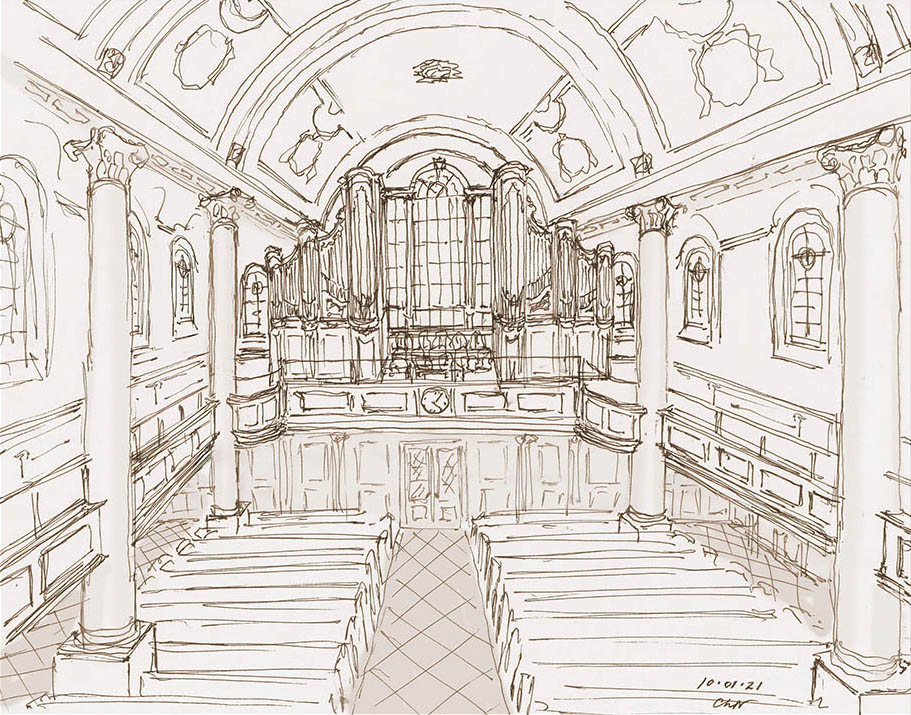
The original organ in St Botolph’s was built in the west gallery by John Byfield the Younger in 1764. In accordance with liturgical fashion, it was moved to the east end of the north aisle in 1867 and enlarged. In 1893 the organ was moved back to the west gallery and the case divided in two either side of the west window. In building the new organ, Fisk will retain the 1893 case layout and create a central console between the two halves, leaving space for singers under the window, and the harmonious and elegant design will allow more natural light into the church. St Botolph’s PCC has received permission from the Diocese of London to undertake the building of this design, provided funds are available.
Funding
St Botolph’s new organ will cost in the region of £1.6 million. The church will start a comprehensive fund-raising campaign next year which will include the search for major sponsors in the City.
Next Steps
As preparation work for the new organ commences, the existing instrument will be removed at the beginning of next year. This will allow for a complete survey of the gallery area where the new organ is to be built. The historic parts of the organ case will be retained to be incorporated into the new organ by Fisk. Some of the pipes which are of historical interest will be stored in the church’s crypt, the rest will be disposed of appropriately.
Fr David Armstrong
Shortly after being appointed the incumbent of St Botolph-without-Bishopsgate, I was astounded to learn that, rather than possessing a suitable pipe organ, musical accompaniment to our services was in the form of a keyboard console in the chancel linked to two large loudspeakers in the gallery.
It seemed incredible that a church with such a strong tradition of music excellence should be limping along with a defunct electronic instrument which is in fact failing. It is a credit to our Director of Music, Iestyn Evans, that he produces such astounding recitals from such an instrument – however, St Botolph’s deserves better. The church ought to have a proper pipe organ restored, and it is my ambition that we should do this to celebrate the current church’s 300th anniversary.
It is sad that we are still living with the legacy of the IRA bomb of nearly 30 years ago which devastated the church building and destroyed the organ. As we mark three decades since that bomb, and start to look to the 300th anniversary of St Botolph’s Georgian splendour, it is time that we work to leave our own constructive legacy by restoring the church to its full grandeur with a beautiful and functional pipe organ in the west gallery. I hope you can help us in whatever way you can to achieve this aspiration.
Fr David
Organ Specifications
Great, 61 notes
| 1. Bourdon 16′ | 61 pipes | wood & metal, stopped |
| 2. Principal 8′ | 61 pipes | metal, open, in façade |
| 3. Harmonic Flute 8′ | 45 pipes* | metal, open & harmonic |
| 4. Spire Flute 8′ | 61 pipes | metal, tapered |
| 5. Octave 4′ | 61 pipes | metal, open |
| 6. Flûte 4′ | 61 pipes | metal, chimneys & à biberon |
| 7. Twelfth 2 2/3′ | 61 pipes | metal, open |
| 8. Fifteenth 2′ | 61 pipes | metal, open |
| 9. Seventeenth 1 3/5′ | 54 pipes | metal, open |
| 10. Mixture IV-VI | 287 pipes** | metal, open |
| 11. Trommet 8′ | 61 pipes | metal, reed |
| 12. Cromorne 8′ | 61 pipes | metal, reed |
* CC-D#0 from No. 4
** A 5 1/3′ rank sounds from g1# when the Bourdon 16′ is also drawn.
Swell, 61 Notes, enclosed
| 13. Quintaton 16′ | 61 pipes | wood & metal, stopped |
| 14. Violin Diapason 8′ | 61 pipes | metal, open, in façade |
| 15. Viole de gambe 8′ | 45 pipes* | metal, open |
| 16. Voix céleste 8′ (from C0) | 49 pipes | metal, open |
| 17. Stopped Diapason 8′ | 61 pipes | wood, stopped |
| 18. Principal 4′ | 61 pipes | metal, open |
| 19. Flûte octaviante 4′ | 61 pipes | metal, open & harmonic |
| 20. Nasard 2 2/3′ | 61 pipes | metal, open |
| 21. Octavin 2′ | 61 pipes | metal, open & harmonic |
| 22. Tierce 1 3/5′ | 54 pipes | metal, open |
| 23. Plein Jeu IV | 232 pipes | metal, open |
| 24. Basson 16′ | 61 pipes | metal, reed |
| 25. Trompette 8′ | 61 pipes | metal, reed |
| 26. Hautbois 8′ | 61 pipes | metal, reed |
Pedal, 32 notes
| 27. Resultant 32′ | 32 notes | from No. 28 or No. 29 |
| 28. Principal Bass 16′ | 32 pipes | wood & metal, open |
| 29. Bourdon 16′ | 32 notes | from No. 1 |
| 30. Octave 8′ | 32 pipes | open, metal |
| 31. Bourdon 8′ | 12 pipes | extension of No. 29 |
| 32. Octave 4′ | 12 pipes | extension of No. 30 |
| 33. Trombone 16′ | 32 pipes | metal, reed |
| 34. Trumpet 8′ | 12 pipes | extension of No. 33 |




